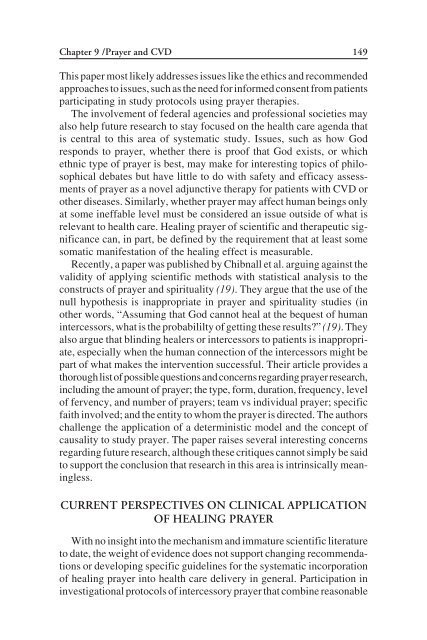Complementary Alternative Cardiovascular Medicine
Complementary Alternative Cardiovascular Medicine
Complementary Alternative Cardiovascular Medicine
Create successful ePaper yourself
Turn your PDF publications into a flip-book with our unique Google optimized e-Paper software.
Chapter 9 /Prayer and CVD 149<br />
This paper most likely addresses issues like the ethics and recommended<br />
approaches to issues, such as the need for informed consent from patients<br />
participating in study protocols using prayer therapies.<br />
The involvement of federal agencies and professional societies may<br />
also help future research to stay focused on the health care agenda that<br />
is central to this area of systematic study. Issues, such as how God<br />
responds to prayer, whether there is proof that God exists, or which<br />
ethnic type of prayer is best, may make for interesting topics of philosophical<br />
debates but have little to do with safety and efficacy assessments<br />
of prayer as a novel adjunctive therapy for patients with CVD or<br />
other diseases. Similarly, whether prayer may affect human beings only<br />
at some ineffable level must be considered an issue outside of what is<br />
relevant to health care. Healing prayer of scientific and therapeutic significance<br />
can, in part, be defined by the requirement that at least some<br />
somatic manifestation of the healing effect is measurable.<br />
Recently, a paper was published by Chibnall et al. arguing against the<br />
validity of applying scientific methods with statistical analysis to the<br />
constructs of prayer and spirituality (19). They argue that the use of the<br />
null hypothesis is inappropriate in prayer and spirituality studies (in<br />
other words, “Assuming that God cannot heal at the bequest of human<br />
intercessors, what is the probabililty of getting these results?” (19). They<br />
also argue that blinding healers or intercessors to patients is inappropriate,<br />
especially when the human connection of the intercessors might be<br />
part of what makes the intervention successful. Their article provides a<br />
thorough list of possible questions and concerns regarding prayer research,<br />
including the amount of prayer; the type, form, duration, frequency, level<br />
of fervency, and number of prayers; team vs individual prayer; specific<br />
faith involved; and the entity to whom the prayer is directed. The authors<br />
challenge the application of a deterministic model and the concept of<br />
causality to study prayer. The paper raises several interesting concerns<br />
regarding future research, although these critiques cannot simply be said<br />
to support the conclusion that research in this area is intrinsically meaningless.<br />
CURRENT PERSPECTIVES ON CLINICAL APPLICATION<br />
OF HEALING PRAYER<br />
With no insight into the mechanism and immature scientific literature<br />
to date, the weight of evidence does not support changing recommendations<br />
or developing specific guidelines for the systematic incorporation<br />
of healing prayer into health care delivery in general. Participation in<br />
investigational protocols of intercessory prayer that combine reasonable


